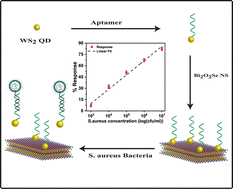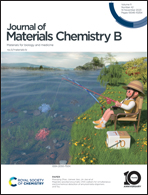Fast detection of Staphylococcus aureus using thiol-functionalized WS2 quantum dots and Bi2O2Se nanosheets hybrid through a fluorescence recovery mechanism†
Abstract
Ultrafast and sensitive detection of Staphylococcus aureus (S. aureus), a harmful Gram-positive human pathogenic bacterium, by two-dimensional layered materials continues to be a challenge. Herein, we have studied the sensing of S. aureus using a tungsten disulfide (WS2) quantum dot (QD) and bismuth oxyselenide (Bi2O2Se) nanosheet (NS) hybrid through their unique optical functionalities. The WS2 QDs of a mean diameter of 2.5 nm were synthesized by liquid exfoliation. Due to the quantum confinement and functional groups, the WS2 QDs exhibit high fluorescence (FL) yield under UV excitation. The addition of Bi2O2Se NSs resulted in the adsorption of WS2 QDs on their surface, resulting in quenching of the FL emission due to nonfluorescent complex formation between the WS2 QDs and Bi2O2Se NSs. A specific sequencing single-standard DNA (ssDNA) aptamer, which identifies and explicitly binds with S. aureus, was attached to the defect sites of the WS2 QDs for selective detection. The thiol-modified ssDNA aptamers attach covalently to the WS2 QD defect sites, which was confirmed by Raman and X-ray photoelectron spectroscopy (XPS). The interaction of S. aureus with the aptamer functionalized WS2 QDs weakens the van der Waals interaction between the WS2 QDs and Bi2O2Se NSs, which results in the detachment of the WS2 QDs from the Bi2O2Se NS surface and restores the FL intensity of the WS2 QDs, thus allowing the efficient detection of S. aureus. Similar measurements with non-targeted bacteria show that the system is quite selective towards S. aureus. Our FL-based biosensor has a linear response in the range of 103–107 CFU mL−1 (colony formation unit mL−1) with a detection limit of 580 CFU mL−1. We have observed a fast response time of 15 minutes for sensing, which is superior to the previous reports. The proposed system was tested in human urine and can detect S. aureus in human urine samples selectively, proving its potential in real-life applications. The reported approach is versatile enough for sensing other biomolecules and metal ions by choosing suitable receptors.

- This article is part of the themed collection: #MyFirstJMCB


 Please wait while we load your content...
Please wait while we load your content...